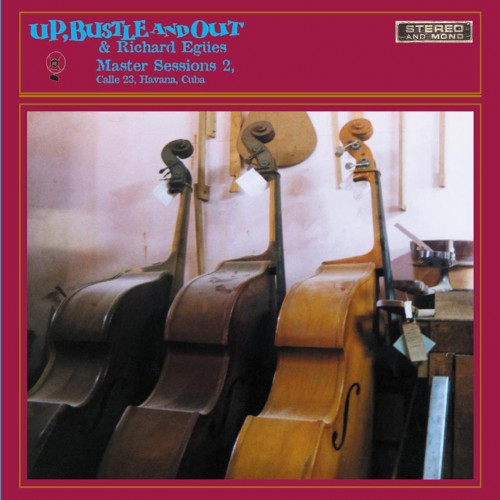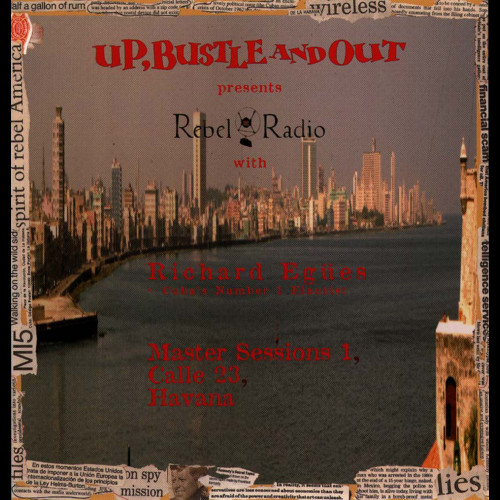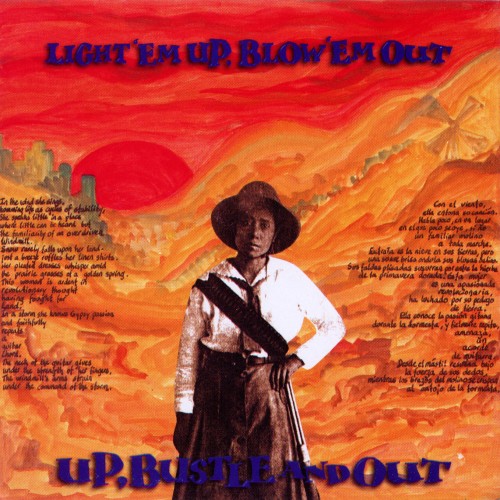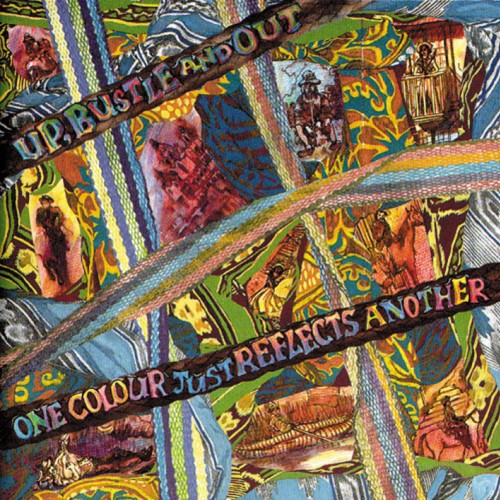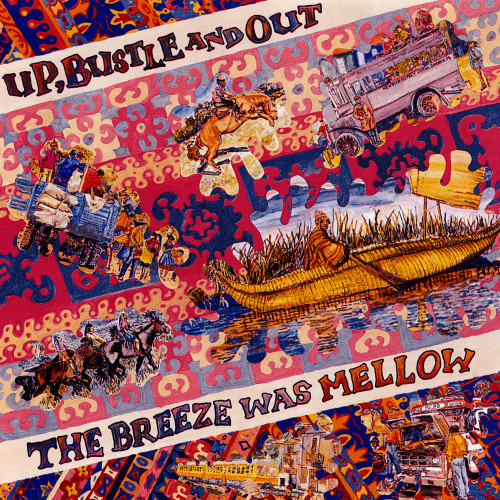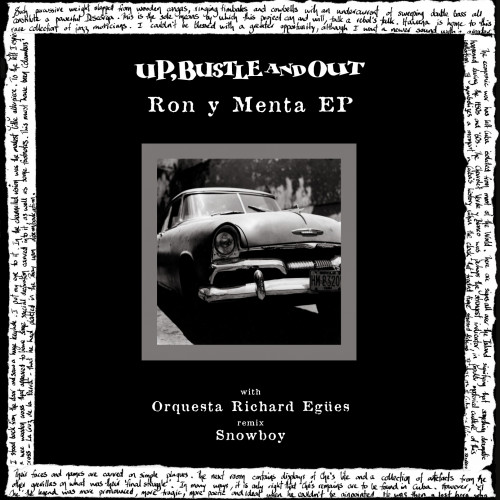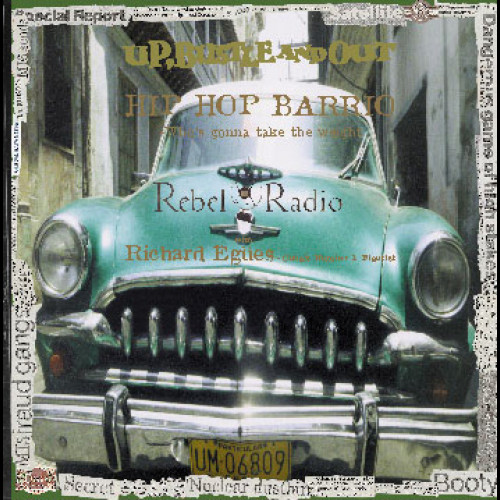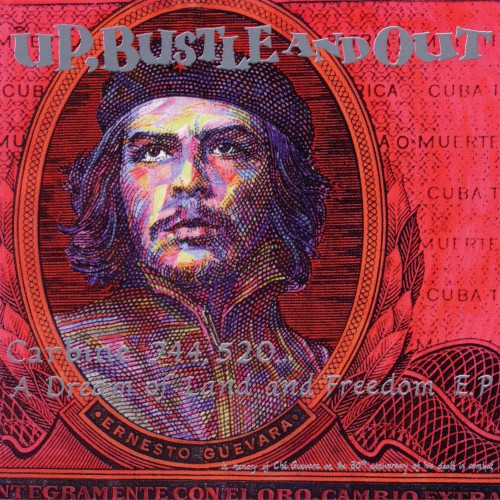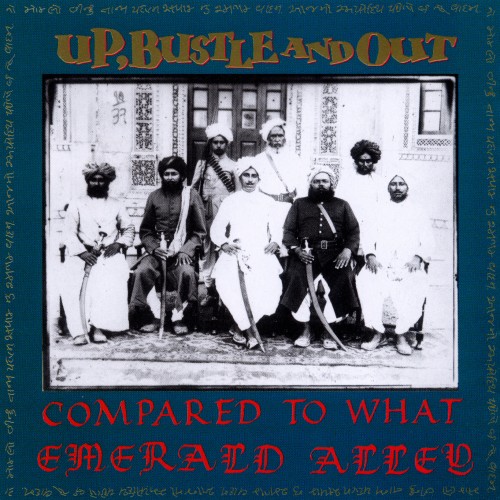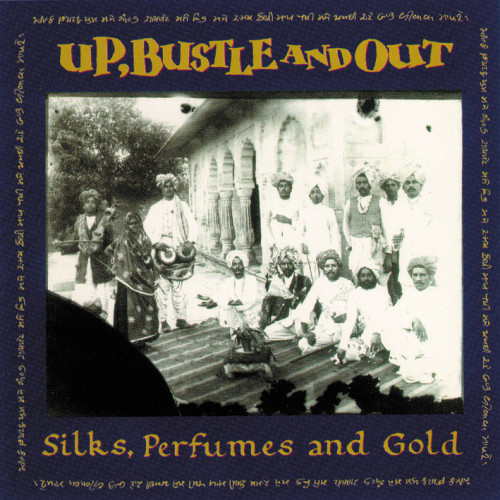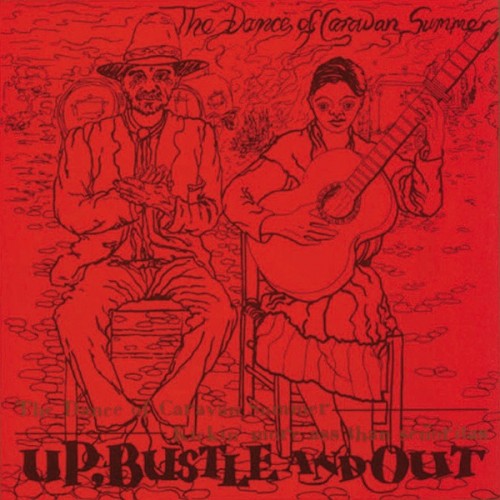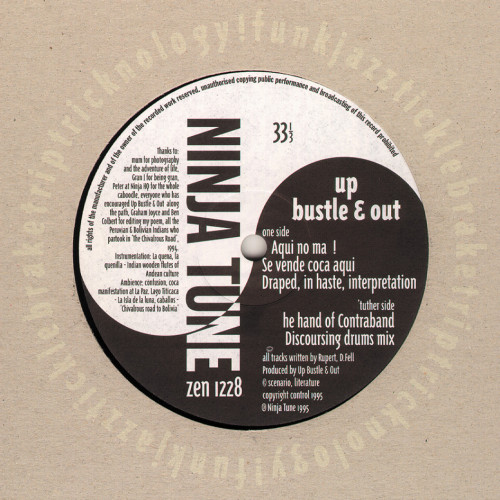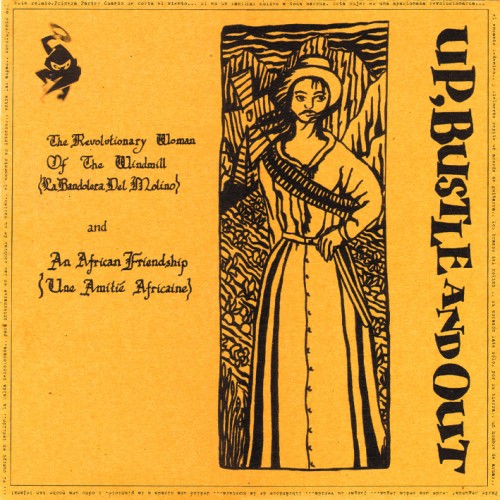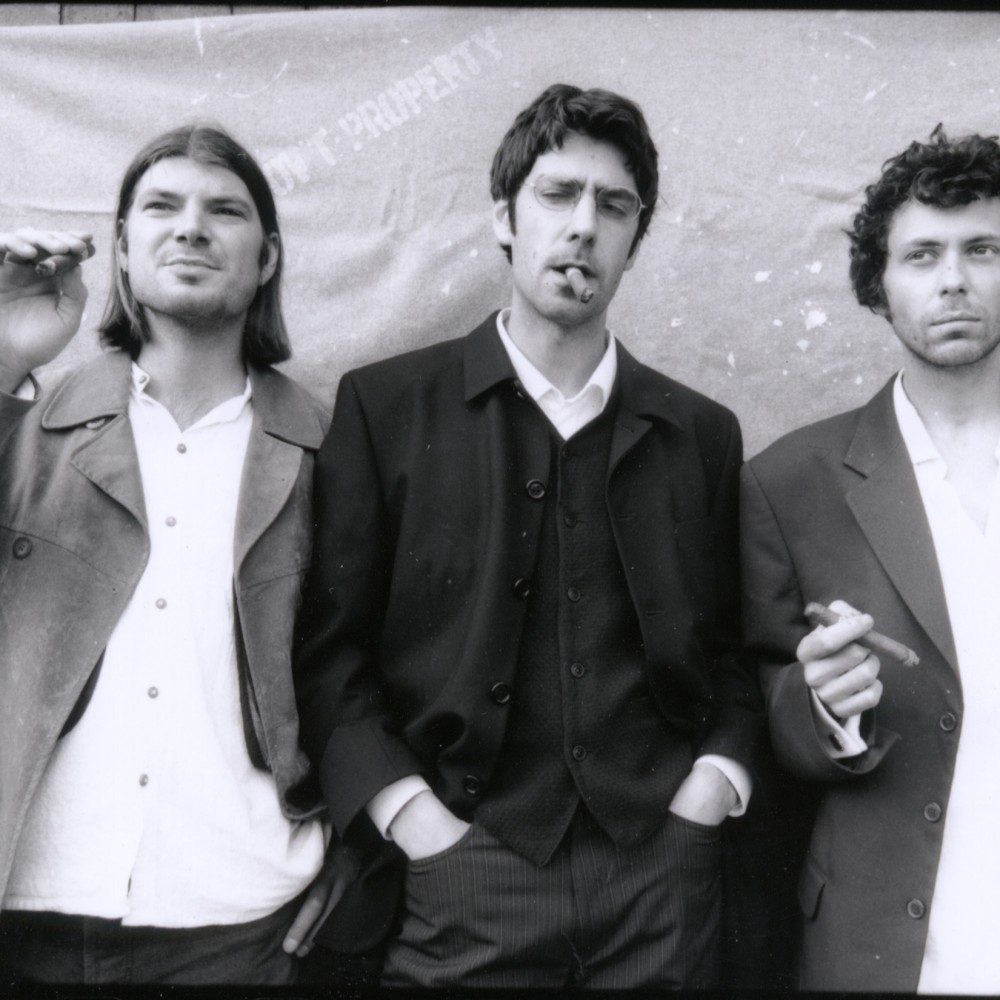
Up, Bustle & Out
On Ninja Tune
BIOGRAPHY
'Cuban Master Sessions 1 & 2, Calle 23, Havana' produced and explored by Up, Bustle and Out There is an intriguing atmosphere hanging dark like Shakespeare's 'Tempest' over Caribbean Seas. This is a 'Master Sessions Series' recorded between two cities from opposing sides of one huge ocean, capturing 'the smokeyness of Bristol and the coolness of Havana'. Could be mistaken for a scene from Graham Greene's novel 'Our Man in Havana' - in fact, this 2-part album serie...
'Cuban Master Sessions 1 & 2, Calle 23, Havana' produced and explored by Up, Bustle and Out There is an intriguing atmosphere hanging dark like Shakespeare's 'Tempest' over Caribbean Seas. This is a 'Master Sessions Series' recorded between two cities from opposing sides of one huge ocean, capturing 'the smokeyness of Bristol and the coolness of Havana'. Could be mistaken for a scene from Graham Greene's novel 'Our Man in Havana' - in fact, this 2-part album series integrates music, literature, and film into one compelling intrigue. Conceptualized, organized and produced from within two Islands: the project knew no such territorial boundaries other than horizons that folded outwards. Drifting dreams sealed like messages in bottles were beached, broken open and the Words, Music and Images took shape from out of the morning sea breezes. Departing from Bristol's Port, 'Up, Bustle and Out' docked at Sonocaribe Studios on Street 23, Havana, then teamed up with co-writer 'Richard Egües', whose rhythm section put the Descarga into everything. The Sound - old style, the Roots - historic, the Studio - classic valves, the Vibes - spiced with sabor, the Cut - Bristol/Cuban blend: sounds and smokes now as good as it did then. So. How did this invitation to record in Cuba with famous Maestros occur? On October 8th 1997 'Up, Bustle and Out' released a timely EP single in memory of Che Guevara on hthe 30th anniversary since his death in combat. Che spoke and lead a socialist revolution with rhythm - 'Socialismo con Pachanga'. This he conveyed via his soft weapon against capitalism - 'Radio Rebelde'. From the initial days of being a crude secret transmitter, Radio Rebelde has grown into becoming Cuba's principal station today. 'Up, Bustle and Out's' tour and recording royalties were used to send this station updated equipment - an offer that was, in turn, to lead to a rare invitation to record in Cuba. The 'Cuban Master Sessions Series' was born - ¡esta nacido! The Music The project was co-written by, the man who forms the roots to popular Cuban music. He is Cuba's number one flautist and orchestrator, and played on the successful 'Rubén González' and 'Buena Vista Social Club' albums. Born in Cruces, Las Villas province in 1926, Richard Egües moved to Santa Clara at an early age. "My house was 'la Casa de la Música. My father was an integral part of the old school directing many bands. Our heads were completely submersed in music. Through his discipline, I studied and learnt a quantity of instruments such as the piano, flute, trumpet, double bass and lots of percussion." Richard dreamt of success - to travel the World as the leader of a famous orchestra. He paid his dues whilst on this magical and unfounded road, performing for various bands. Then came the break. The founder of 'Orquesta Aragón', 'Orestes Aragón Cantero' invited Richard to play his flute with the Boys as a stand-in. The cheeky, choppy, and flirty Latin melodies cast a spell over the entire audience. Richard was invited in as a full member. From their foundation in Cienfuegos, 1939 the orchestra moved permanently to Havana in 1955. Richard didn't harbour a solitary reservation - mystical Havana emanated music. 'Radio Progreso' opened the doors to fame for Orquesta Aragón by serious plugging across the Antilles airwaves. Their status grew to levels defined by sheer folly with albums selling 30,000 copies in Puerto Rico alone! From here the story reads explosively - World sell out tours, Richard becomes the band's leading orchestrator, recognition as Cuba's number one flautist, composes and performs over 100 themes of which interpreters include 'Nat King Cole', TV appearances and, of course, the glitzy shows in Havana's reputed Cabarets. In 1984, Richard left Orquesta Aragón forming his own - 'Orquesta Richard Egües', with whom he performed on this 'Master Sessions' series. Today, Richard and the Boys comprise a unique ensemble of vintage Salsa musicians that only Cuba boasts. They are 'Los Maestros'. Every Maestro has a confidante - in Richard's case his support, friendship and spirit is carried in the coolest of them all. His name is 'Peñalver'. When asked why the orchestra didn't leave Cuba like so many musicians did during the 1960s Peñalver responded calmly, "Listen, look, feel the rhythm in the streets. Havana is our history, the roots from which we spring." Richard would be chuffed to know that his right hand man had spoken these Words for him between mild puffs on his fat Havana cigar. The two mainstays of Up, Bustle & Out are ' Clandestine' Ein and Rupert Mould. 'Clandestine' Ein is the man behind the beats of 'Up ,Bustle and Out'. This renown recycler of vinyl will stop at nothing to find those elusive sounds, cleverly montaged together to create eclectic backing trax. His most recent haul of old 33's was still smouldering from a severe scorching in a fierce shop blaze, a bit singed round the edges, yet still playable. "We start off with hundreds of ideas, find out what fits and melt them all together into a demo," says Ein, "then hand it all over to some of Bristol's best jazz muso's for the finishing touches." Experimentation is the root - especially when it comes to the final mix with plenty of behind-the-scenes dub-effects and ambient treatments. "We love our 'Air Mixes' and hope to release them on a separate album one day." Rupert Mould is an unusual fusion of Eastern European Gypsy blood and English aristocracy, of a voyage to the Americas when Europe appeared old and disenchanted, of a Grandmother who worked her whole life so that the family could be educated in Universities; these are the experiences that contributed to the ways in which Rupert Mould saw the World develop. Part anchored, part adrift. He met 'Clandestine Ein' in 1989 whilst hosting a Pirate Radio show. 'For the People' radio boasted Bristol's most inspiring DJs - Daddy G & The Massive Attack, Smith & Mighty. This hooded scene grew into a club - The Moon Club where folk sweated to Rare Grooves, Hip Hop, Jamaican Dub and Latin. Then out of the blue beats, they were all cutting vinyl - an exciting, inspiring and important development. Rupert Mould has now conceived and produced 5 albums for U, B & O and Ninja Tune. So many of the songs are instrumentals, creating imagery within the music. The 'Cuban Master Sessions Series' was intended to set new ground upon broken ground; expanding into the production and collaborations with other artists, shooting films on Super 8 and cementing all this in the ubiquitous power of the written Word. With so much being said and written about Cuba: passions and admiration running deep and strong, such a famous Island, proud people, definitive colours, a rich and tragic history and, ravished colonial gems, meant that the albums needed enriching with grainy film and a book. Mr Jules 'Shoes' Elvins of 'Waldo Films, London' shot 16 mm and Super 8 footage throughout the Island, incorporating revolutionary archive material, studio frames, urban and inland scenes. These have been eclectically cut and set to the music as a CD-ROM. And then came the book - 'The Rebel Radio Diary', which often contrasts the Diaries of Columbus when he chanced upon the Bay of Baracoa, Cuba, 1492, and Che Guevara when he disembarked in 1956. 'The Rebel Radio Diary' is termed a 'social-historical, poetic-travelogue' novel that has been edited by Alice Grandison - freelance editor for 'Canongate Books, Edinburgh'. It will be distributed nationally by 'Gazelle Books' to all good book stores. The Diary, as well as comprising direct entries of observation, is also intended to be historical, humorous, real, fantastic, romantic, poetic and, above all, captured through an Aperture of Youth. We leave You with a taster: "I'd recorded this persuasive percussion the previous night on my portable DAT player at a Santería-inspired backyard event. It was a timeless and weird event: sluggish bare feet pounded the dry earth to the magnifying power of the percussion maestro. It was hypnotic; twirling bodies stirred up the dust and the vision became sepia. In the centre was a black spiritualist who chanted a repetitive line. His voice was weighty and obscured amid the conga's bass frequencies. Other people replied to his chants in concert, but I became lost in a daze of dust that rose and fell like a tired-out lava lamp. My face was sprayed with rum. Someone spat it out in a fine spray that sweetened my face and partially woke me. This was Afro-Cuban Brujería, or witchcraft."
Up, Bustle & Out
On Ninja Tune
Albums
Singles
Latest News
BIOGRAPHY
'Cuban Master Sessions 1 & 2, Calle 23, Havana' produced and explored by Up, Bustle and Out There is an intriguing atmosphere hanging dark like Shakespeare's 'Tempest' over Caribbean Seas. This is a 'Master Sessions Series' recorded between two cities from opposing sides of one huge ocean, capturing 'the smokeyness of Bristol and the coolness of Havana'. Could be mistaken for a scene from Graham Greene's novel 'Our Man in Havana' - in fact, this 2-part album series integrates music, ...
'Cuban Master Sessions 1 & 2, Calle 23, Havana' produced and explored by Up, Bustle and Out There is an intriguing atmosphere hanging dark like Shakespeare's 'Tempest' over Caribbean Seas. This is a 'Master Sessions Series' recorded between two cities from opposing sides of one huge ocean, capturing 'the smokeyness of Bristol and the coolness of Havana'. Could be mistaken for a scene from Graham Greene's novel 'Our Man in Havana' - in fact, this 2-part album series integrates music, literature, and film into one compelling intrigue. Conceptualized, organized and produced from within two Islands: the project knew no such territorial boundaries other than horizons that folded outwards. Drifting dreams sealed like messages in bottles were beached, broken open and the Words, Music and Images took shape from out of the morning sea breezes. Departing from Bristol's Port, 'Up, Bustle and Out' docked at Sonocaribe Studios on Street 23, Havana, then teamed up with co-writer 'Richard Egües', whose rhythm section put the Descarga into everything. The Sound - old style, the Roots - historic, the Studio - classic valves, the Vibes - spiced with sabor, the Cut - Bristol/Cuban blend: sounds and smokes now as good as it did then. So. How did this invitation to record in Cuba with famous Maestros occur? On October 8th 1997 'Up, Bustle and Out' released a timely EP single in memory of Che Guevara on hthe 30th anniversary since his death in combat. Che spoke and lead a socialist revolution with rhythm - 'Socialismo con Pachanga'. This he conveyed via his soft weapon against capitalism - 'Radio Rebelde'. From the initial days of being a crude secret transmitter, Radio Rebelde has grown into becoming Cuba's principal station today. 'Up, Bustle and Out's' tour and recording royalties were used to send this station updated equipment - an offer that was, in turn, to lead to a rare invitation to record in Cuba. The 'Cuban Master Sessions Series' was born - ¡esta nacido! The Music The project was co-written by, the man who forms the roots to popular Cuban music. He is Cuba's number one flautist and orchestrator, and played on the successful 'Rubén González' and 'Buena Vista Social Club' albums. Born in Cruces, Las Villas province in 1926, Richard Egües moved to Santa Clara at an early age. "My house was 'la Casa de la Música. My father was an integral part of the old school directing many bands. Our heads were completely submersed in music. Through his discipline, I studied and learnt a quantity of instruments such as the piano, flute, trumpet, double bass and lots of percussion." Richard dreamt of success - to travel the World as the leader of a famous orchestra. He paid his dues whilst on this magical and unfounded road, performing for various bands. Then came the break. The founder of 'Orquesta Aragón', 'Orestes Aragón Cantero' invited Richard to play his flute with the Boys as a stand-in. The cheeky, choppy, and flirty Latin melodies cast a spell over the entire audience. Richard was invited in as a full member. From their foundation in Cienfuegos, 1939 the orchestra moved permanently to Havana in 1955. Richard didn't harbour a solitary reservation - mystical Havana emanated music. 'Radio Progreso' opened the doors to fame for Orquesta Aragón by serious plugging across the Antilles airwaves. Their status grew to levels defined by sheer folly with albums selling 30,000 copies in Puerto Rico alone! From here the story reads explosively - World sell out tours, Richard becomes the band's leading orchestrator, recognition as Cuba's number one flautist, composes and performs over 100 themes of which interpreters include 'Nat King Cole', TV appearances and, of course, the glitzy shows in Havana's reputed Cabarets. In 1984, Richard left Orquesta Aragón forming his own - 'Orquesta Richard Egües', with whom he performed on this 'Master Sessions' series. Today, Richard and the Boys comprise a unique ensemble of vintage Salsa musicians that only Cuba boasts. They are 'Los Maestros'. Every Maestro has a confidante - in Richard's case his support, friendship and spirit is carried in the coolest of them all. His name is 'Peñalver'. When asked why the orchestra didn't leave Cuba like so many musicians did during the 1960s Peñalver responded calmly, "Listen, look, feel the rhythm in the streets. Havana is our history, the roots from which we spring." Richard would be chuffed to know that his right hand man had spoken these Words for him between mild puffs on his fat Havana cigar. The two mainstays of Up, Bustle & Out are ' Clandestine' Ein and Rupert Mould. 'Clandestine' Ein is the man behind the beats of 'Up ,Bustle and Out'. This renown recycler of vinyl will stop at nothing to find those elusive sounds, cleverly montaged together to create eclectic backing trax. His most recent haul of old 33's was still smouldering from a severe scorching in a fierce shop blaze, a bit singed round the edges, yet still playable. "We start off with hundreds of ideas, find out what fits and melt them all together into a demo," says Ein, "then hand it all over to some of Bristol's best jazz muso's for the finishing touches." Experimentation is the root - especially when it comes to the final mix with plenty of behind-the-scenes dub-effects and ambient treatments. "We love our 'Air Mixes' and hope to release them on a separate album one day." Rupert Mould is an unusual fusion of Eastern European Gypsy blood and English aristocracy, of a voyage to the Americas when Europe appeared old and disenchanted, of a Grandmother who worked her whole life so that the family could be educated in Universities; these are the experiences that contributed to the ways in which Rupert Mould saw the World develop. Part anchored, part adrift. He met 'Clandestine Ein' in 1989 whilst hosting a Pirate Radio show. 'For the People' radio boasted Bristol's most inspiring DJs - Daddy G & The Massive Attack, Smith & Mighty. This hooded scene grew into a club - The Moon Club where folk sweated to Rare Grooves, Hip Hop, Jamaican Dub and Latin. Then out of the blue beats, they were all cutting vinyl - an exciting, inspiring and important development. Rupert Mould has now conceived and produced 5 albums for U, B & O and Ninja Tune. So many of the songs are instrumentals, creating imagery within the music. The 'Cuban Master Sessions Series' was intended to set new ground upon broken ground; expanding into the production and collaborations with other artists, shooting films on Super 8 and cementing all this in the ubiquitous power of the written Word. With so much being said and written about Cuba: passions and admiration running deep and strong, such a famous Island, proud people, definitive colours, a rich and tragic history and, ravished colonial gems, meant that the albums needed enriching with grainy film and a book. Mr Jules 'Shoes' Elvins of 'Waldo Films, London' shot 16 mm and Super 8 footage throughout the Island, incorporating revolutionary archive material, studio frames, urban and inland scenes. These have been eclectically cut and set to the music as a CD-ROM. And then came the book - 'The Rebel Radio Diary', which often contrasts the Diaries of Columbus when he chanced upon the Bay of Baracoa, Cuba, 1492, and Che Guevara when he disembarked in 1956. 'The Rebel Radio Diary' is termed a 'social-historical, poetic-travelogue' novel that has been edited by Alice Grandison - freelance editor for 'Canongate Books, Edinburgh'. It will be distributed nationally by 'Gazelle Books' to all good book stores. The Diary, as well as comprising direct entries of observation, is also intended to be historical, humorous, real, fantastic, romantic, poetic and, above all, captured through an Aperture of Youth. We leave You with a taster: "I'd recorded this persuasive percussion the previous night on my portable DAT player at a Santería-inspired backyard event. It was a timeless and weird event: sluggish bare feet pounded the dry earth to the magnifying power of the percussion maestro. It was hypnotic; twirling bodies stirred up the dust and the vision became sepia. In the centre was a black spiritualist who chanted a repetitive line. His voice was weighty and obscured amid the conga's bass frequencies. Other people replied to his chants in concert, but I became lost in a daze of dust that rose and fell like a tired-out lava lamp. My face was sprayed with rum. Someone spat it out in a fine spray that sweetened my face and partially woke me. This was Afro-Cuban Brujería, or witchcraft."

